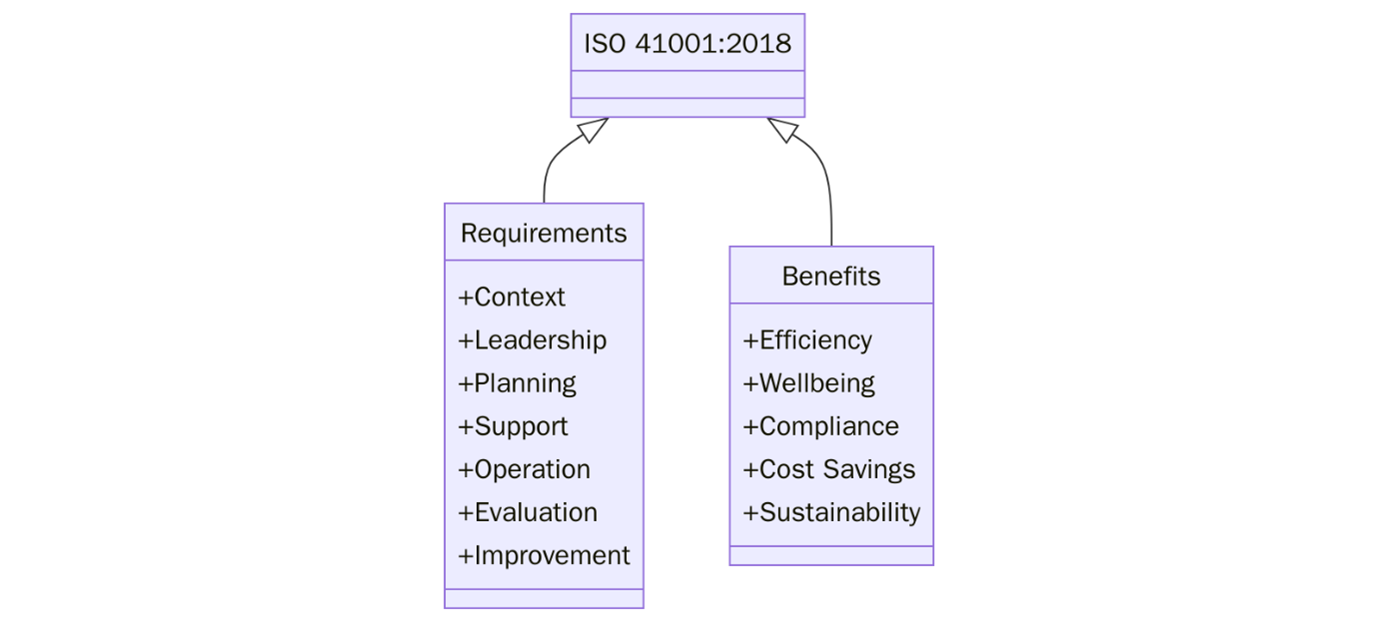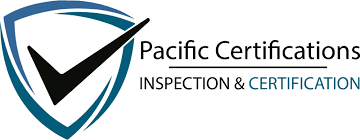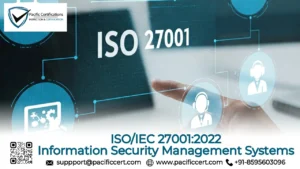What is ISO 41001:2018?

ISO 41001:2018 is the first international standard that specifies requirements for a facility management (FM) system. It provides a framework for organizations to establish, implement, maintain, and improve an integrated FM system, ensuring that facility services support core business objectives consistently and effectively.

The standard elevates facility management from an operational function to a strategic discipline by aligning it with business goals, improving workplace performance, and driving value across the organization. Whether applied in-house or outsourced, ISO 41001 supports organizations in managing the lifecycle of buildings & resources while improving safety & sustainability.
As facilities become more complex and organizations demand smarter, safer, and more sustainable environments, ISO 41001 offers a formal system to professionalize FM and improve service delivery.
Looking to get certified according to ISO 41001? Contact us at support@pacificcert.com!
Scope and Applicability
ISO 41001 is applicable to:
- Organizations providing FM services internally (in-house)
- Third-party FM service providers (outsourcing firms)
- Public and private sectors across all industries
- Educational institutions, hospitals, government buildings, and corporate offices
- Multi-site operations, industrial facilities, and shared service hubs
The standard is designed to be flexible, allowing organizations of all sizes and types to tailor the FM system to their specific operational and strategic contexts.
Want to explore if ISO 41001 fits your organization? Email us at support@pacificcert.com.
Certification Process
Organizations can achieve ISO 41001 certification through an accredited third-party audit process, validating their facility management system against international best practices.
The Certification Process Includes:
- Gap Assessment – Review current FM structure, policies, and performance metrics.
- System Design – Define roles, objectives, asset strategies, and risk assessments.
- Implementation – Train staff, implement controls, and ensure effective service integration.
- Internal Audit & Management Review – Evaluate system readiness and performance.
- Third-Party Audit – Conducted by an accredited certification body.
We guide organizations through every phase, from certification and post-certification support. For assistance, contact support@pacificcert.com.
ISO 41001:2018 provides a framework to develop, implement, and maintain effective facility management (FM) systems. It aligns with other ISO management system standards using the High-Level Structure (HLS), promoting integration with standards like ISO 9001 and ISO 14001.
Below is the clause-wise structure of ISO 41001:2018:
Clause-wise Structure of ISO 41001:2018
Clause | Title | Description |
1 | Scope | Defines the purpose and applicability of the standard to any organization, regardless of type, size, or nature, that seeks to demonstrate effective FM capabilities. |
2 | Normative References | Lists any reference documents necessary for the application of the standard. For ISO 41001, there are no normative references. |
3 | Terms and Definitions | Provides key FM-related terminology to ensure a common understanding among users. Includes terms such as “facility”, “facility management system”, and “support service”. |
4 | Context of the Organization | Requires organizations to understand internal/external issues, identify stakeholders, and define the scope and boundaries of the FM system. |
5 | Leadership | Emphasizes the role of top management in demonstrating leadership, establishing an FM policy, and assigning responsibilities to ensure effectiveness. |
6 | Planning | Covers actions to address risks and opportunities, establish FM objectives, and plan actions to achieve them. |
7 | Support | Focuses on the resources needed for FM, including competence, awareness, communication, and documented information. |
8 | Operation | Describes the implementation of processes to meet FM system requirements and control outsourced functions. |
9 | Performance Evaluation | Requires monitoring, measurement, analysis, evaluation, internal audits, and management review of the FM system. |
10 | Improvement | Covers nonconformity handling, corrective actions, and continual improvement of the FM system. |
How to Implement ISO 41001:2018 in Your Organization?
Implementing ISO 41001 requires organizations to view FM as a strategic partner rather than just an operational unit. Here’s how:
Step 1: Assess FM Context and Scope
Define your FM service environment, including internal departments, external providers, infrastructure, and stakeholders.
Step 2: Develop FM Policies and Objectives
Align FM with organizational strategy, stakeholder needs, and regulatory requirements.
Step 3: Assign Roles and Responsibilities
Appoint FM leaders, form cross-functional teams, and define service-level expectations.
Step 4: Plan and Control FM Activities
Create documented processes for procurement, maintenance, energy management, workplace safety, and more.
Step 5: Monitor, Measure, and Review
Use performance metrics, audits, and feedback to improve FM performance and service quality.
We at Pacific Certifications provide tailored certification support for ISO 41001, contact us at support@pacificcert.com.
What Documentation is Required for ISO 41001:2018?
Organizations seeking ISO 41001 certification should maintain:
- FM policy and strategic objectives
- Stakeholder analysis and communication plans
- FM risk assessments and legal compliance documents
- Service-level agreements (SLAs) and performance indicators
- Standard operating procedures for key FM activities
- Maintenance and lifecycle plans for assets
- Emergency preparedness and sustainability programs
- Internal audit and management review records
Need help? Contact support@pacificcert.com for audit & certification support!
What are the Eligibility Criteria for ISO 41001:2018?
ISO 41001 is ideal for:
- FM departments in large enterprises, hospitals, schools, or commercial buildings
- Outsourced FM service providers managing properties across multiple sites
- Organizations aiming to align facility services with business goals
- Public sector entities and infrastructure authorities managing complex real estate portfolios
Any organization involved in FM, directly or indirectly can benefit from the structure and credibility ISO 41001 provides.
Still unsure if ISO 41001 is right for you? Contact support@pacificcert.com!
What are the Certification Costs of ISO 41001:2018?
The cost of ISO 41001 certification is influenced by:
- Size of the organization and facility portfolio
- Complexity of FM operations (single site vs. multi-site, outsourced vs. in-house)
- Integration with other ISO management systems (e.g., ISO 9001, ISO 45001)
- Current maturity of the FM framework and readiness
- Training, audit preparation, and documentation development needs
We provide clear, tailored cost estimates after a scoping consultation. Contact us at support@pacificcert.com.
What is the Certification Timeline of ISO 41001:2018?
Week | Activities |
Week 1 | Scope definition, stakeholder mapping, initial gap analysis |
Week 2 | FM policy development, objectives setting, risk assessment |
Week 3 | SOPs creation, document control, and operational alignment |
Week 4 | Staff training, KPI setup, and compliance verification |
Week 5 | Internal audit, system performance review |
Week 6 | Certification audit and final corrective actions |
Want to align your FM timeline with organizational goals? Reach out to us at support@pacificcert.com
What are the Requirements of ISO 41001:2018?
ISO 41001 outlines a structured framework covering the following requirements:

- Understanding the Organization and FM Context – Define internal and external factors influencing facility performance.
- Leadership and Governance – Ensure top-level commitment, strategic alignment, and responsibility assignment.
- Planning – Identify risks and opportunities, establish measurable FM objectives, and define service plans.
- Support – Provide adequate resources, competencies, infrastructure, and communication strategies.
- Operation – Manage lifecycle processes for assets, services, and workplace infrastructure.
- Performance Evaluation – Use audits, KPIs, and feedback to monitor and improve FM results.
- Improvement – Drive corrective actions, innovation, and continuous service improvement.
Pacific Certifications supports you in translating these requirements into a practical and audit-ready FM system. Contact support@pacificcert.com!
What are the Benefits of ISO 41001:2018?
- Ensures that facility services directly support the organization’s mission, vision, and core processes.
- Delivers consistent, high-quality facilities that meet user needs and improve the workplace experience.
- Standardizes procedures, optimizes resource use, and reduces waste, resulting in long-term savings.
- Identifies FM-related risks and ensures legal and regulatory compliance across operations.
- Encourages responsible resource use, supports green building goals, and reduces environmental impact.
- Enhances workplace conditions through safety protocols, maintenance standards, and emergency readiness.
- Demonstrates commitment to internationally accepted FM practices, building stakeholder confidence.
- Easily aligns with ISO 9001 (quality), ISO 45001 (OH&S), and ISO 14001 (environment) frameworks.

In 2025, facility management is undergoing a major transformation driven by technology, ESG requirements, and a heightened focus on workplace well-being. According to IFMA (International Facility Management Association), global demand for certified FM frameworks has grown by over 35% in the past two years.
Governments and large corporations are requiring ISO 41001 certification for FM service providers to ensure service transparency, risk control, and environmental accountability. The FM industry, now valued at over USD 1.4 trillion globally, is prioritizing smart building technologies, predictive maintenance, and sustainable design, areas where ISO 41001 provides a foundational management structure.
ISO 41001 is now being referenced in procurement specifications, contract management, and regulatory frameworks across healthcare, government, education, and high-risk industrial sectors.
Want to align your FM system with global standards and trends? Email us at support@pacificcert.com
How Pacific Certifications Can Help?
We at Pacific Certifications offer complete ISO 41001 support services, including:
- Pre Audit support
- Audit & certification
- Ongoing support
- Surveillance
Whether you’re an FM provider or managing facilities internally, we help you build a reliable, integrated system that meets ISO 41001 requirements.
Get started with expert support, contact us at support@pacificcert.com!
FAQ on ISO 41001:2018
What is ISO 41001 certification?
ISO 41001 is the international standard for a Facility Management (FM) system. It provides a framework to develop, implement, and maintain effective facilities management across different sectors worldwide.
What is ISO 14001 in simple terms?
ISO 14001 is the internationally recognized standard for environmental management systems (EMS). It provides a framework for organizations to design and implement an EMS, and continually improve their environmental performance.
Can ISO 41001 be integrated with ISO 9001 or ISO 45001?
Yes, it shares the Annex SL structure, making integration seamless.
Is ISO 41001 suitable for a single-site operation?
Absolutely. The standard scales to both single-site and multi-site operations.
How long does certification take?
Typically 6–8 weeks, depending on readiness, complexity, and documentation.
Ready to get ISO 41001:2018 certified?
Contact Pacific Certifications to begin your certification journey today!
Suggested Certifications –
Read more: Pacific Blogs






